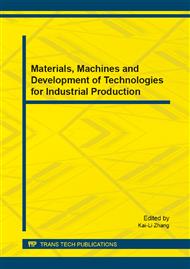p.105
p.109
p.114
p.120
p.125
p.131
p.136
p.140
p.146
Synthesis of Epoxy-Functionalized Micro-Zone Plates by UV-Initiated Copolymerization
Abstract:
As microfluidic systems transition from research tools to disposable clinical devices, new substrate materials are need to meet both the regulatory requirement as well as the economics of disposable devices. In this paper, a commercial ultraviolet (UV)-curiable material (bisphenol A based epoxy acrylate, BABEA) was introduced as a new manufacturing material for facile fabrication of epoxy-functionalized microfluidic devices by UV-initiated copolymerization. X-ray photoelectron spectroscope (XPS) results indicated the existence of epoxy groups on the surface of poly (BABEA-co-GMA), which allowed for binding protein through an epoxy-amino group reaction. Poly (BABEA-co-GMA) is highly transparent in visible range, and of high replication fidelity. A fabrication procedure was proposed for manufacturing BABEA based epoxy-functionalized micro-zone plates. The fabrication procedure was very simple; obviating the need of micromachining equipments, wet etching or imprinting techniques. To evaluate the BABEA based epoxy-functionalized micro-zone plates, α-fetoprotein (AFP) antibody was immobilized onto the capture zone for chemiluminescent (CL) detection in a non-competitive immune response format. The proposed AFP immunoaffinity micro-zone plate was demonstrated as a low cost, flexible, homogeneous and stable assay for AFP.
Info:
Periodical:
Pages:
125-130
Citation:
Online since:
August 2014
Authors:
Keywords:
Price:
Сopyright:
© 2014 Trans Tech Publications Ltd. All Rights Reserved
Share:
Citation:


